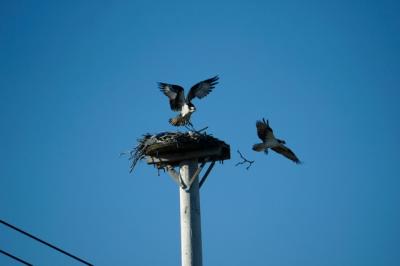Ospreys Return But Threats Remain

The osprey were a couple of days late this week — or they were right on time. It depended on whom you asked and where, in turn, they were looking.
Two seen on March 26 appeared to be checking out the suitability of a nesting platform along the side of Napeague Meadow Road. They landed and perched tentatively, then rose and did it again, appearing unsure of whether this would make a good home for the summer. In Water Mill, two osprey appeared to joust over the attention of a third, which had settled comfortably onto her own platform with the intention perhaps of nesting and laying her eggs.
Time was that osprey, or what locals call fish hawks, were few and far between on the South Fork. The widespread use of D.D.T., an effective pesticide to control mosquitoes, had the terrible effect of weakening their eggshells, and their population plummeted. Gardiner’s Island became one of their only breeding grounds. After D.D.T. was banned in 1972, their numbers began to increase. Today, osprey are common again — a testament to sensible regard for the natural world. So, too, has the number of bald eagles grown, among other birds of prey.
But threats remain for the osprey. They are top-level predators, which means that the contaminants that fish lower on the food chain consume accumulate in their bodies. Though D.D.T. is gone, plenty of other pesticides, manufacturing agents, furniture flame retardants, and pharmaceuticals continue to pour into the environment here — many via inadequate residential septic systems. Elsewhere, osprey are used by researchers to monitor contaminants. For example, the chicks in an osprey population in Montana were found with off-the-charts levels of mercury related to copper mine sludge.
Local governments on the East End are studying options, including remediation projects already begun or in the planning stages, as in the Hook Pond and Georgica watersheds in East Hampton. As we look at osprey this spring and marvel at their lengthy migration and stunning efficiency at catching fish, we should think as well about the world that they — and we — live in, and if we all can do more to keep it — and ourselves — well.
